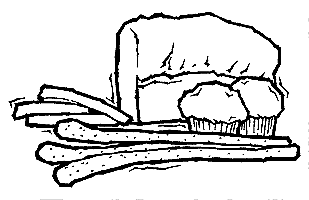

 show #1205
show #1205

Insights & Connections
Vocabulary
Resources
Main activity
Try this
Bread baking transforms an ordinary kitchen into a laboratory of earthy sights, smells, and tastes. A recipe, after all, reads like a scientific experiment. The baker combines flour, yeast, liquid, and salt in a bowl, shapes it all into a dough, lets the dough rise, and bakes it in a hot oven.
Flour, which gives bread its structure, is made by milling cereal grains such as wheat, barley, or rye. In this process, the grain seeds are crushed, releasing starch and proteins.
Starch molecules are long, gangly polymers of simple sugars linked head to tail by chemical bonds. Proteins are more complex--a single protein may contain hundreds of amino acids strung together like beads on a necklace.
What gives bread its light, fluffy texture? The answer is gliadin and glutenin, two proteins found in flour. When flour is added to water and kneaded, these proteins swell up like sponges and form a tough elastic substance called gluten. Gluten can stretch and trap the bubbles of gas that make dough rise.
That gas comes from the leavening action of tiny one-celled fungi called yeast. When you combine yeast with flour and water, you'll end up with a sticky white dough. Inside the dough, fermentation is occurring and molecules are on the move. Enzymes from the yeast cells attack starch, breaking it down into glucose. Other enzymes transform glucose molecules into carbon dioxide and ethanol. The carbon dioxide (CO2) gas then bubbles up through the mixture, causing the dough to rise.
Breads which are leavened by baking powder instead of yeast lack the tasty molecules of fermented bread. That's because when baking powder gets wet, a chemical reaction occurs that releases only carbon dioxide, salt, and water.
In breads leavened with yeast, however, the yeast cells grow under anaerobic conditions and cannot convert glucose molecules completely to gas. Some sugar molecules get sidetracked and are converted into alcohols, acids, and esters--substances which add to bread's flavor.
Salt strengthens gluten by slowing down the enzymes which catalyze the breakdown of proteins. If you add too little salt, the dough is tough and sticky. If you add too much, water flows out of yeast cells by osmosis. Then nutrients are lost and production of carbon dioxide slows down.
After dough rises a couple of hours in a warm place, it's ready to go into the oven. There, heat causes pockets of gas in the dough to expand. Eventually the crust becomes toasty brown--and soon you're enjoying a slice of warm, home-baked bread.
anaerobic a process which takes place in the absence of oxygen
catalyze to speed up a chemical reaction
chemical bond the forces of attraction that bind atoms together in a molecule
chemical reaction a process where substances are changed into new substances
enzyme special protein molecules that speed up chemical reactions in living cells. Enzymes are biological catalysts.
fermentation a process where sugars are transformed into carbon dioxide and alcohol by the action of yeast enzymes
leavening substances that cause fermentation
polymer large molecules formed by linking together many small molecules. Proteins are polymers of amino acids.
General Mills Number 1 General Mills Blvd. Minneapolis, MN 55426 (612) 540-7768 American Institute of Baking 1213 Bakers Way Manhattan, KS 66502 (913) 537-4750
County extension office
Local bakery
Home economics teacher
Local milling company

Yeast cells are tiny one-celled plants. Baker's yeast contains billions of cells in a single package. Each egg-shaped cell is, on average, five micrometers wide (1/10,000 of an inch). In this activity you will grow some yeast cells and study them with a microscope.

 TRY THIS!
TRY THIS! TRY THIS!
TRY THIS!
 TRY THIS!
TRY THIS!
 TRY THIS!
TRY THIS!